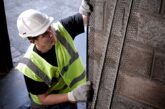British Gypsum is as close to a household name as you can get in the construction industry and it’s a company that has a proud heritage in British innovation and engineering.
Now part of the Saint-Gobain group, British Gypsum is celebrating 100 years since seven men met for the first official meeting of The British Plaster Board in the Crown & Mitre Hotel, Carlisle in May 1917. Here we take a look at how it all started and what lies ahead for this iconic brand.
Producing innovative, cost effective and high performance interior lining systems, British Gypsum now operates five UK manufacturing sites that are very much a product of the commitment and spirit of the local people. Respected as a generational employer in the communities it operates in, the company’s roots in gypsum products run deep with its Thistle and Gyproc brands being around for most of its history. Surprisingly, plasterboard has been around a lot longer than people think, in fact, it was first made in the UK in 1912.
So here are some fast facts and a closer look at the 100-year story of British Gypsum:
Fast Facts:
- Europe’s largest plaster plant can supply 1 million homes with plaster in a year.
- Enough plasterboard is made every three months to reach the moon and back
- Delivers products to over 3,500 stockists nationwide
- Operates 5 mines across the UK
![]() 1917
1917
With mining operations dating back to 1876, it wasn’t until 1917 that the British Plaster Board Company (BPB) began.
1930s – British Gypsum opened its new plant at Erith, Kent making 30,000 square yards a day. First ‘Green book of Plastering’ was published.
1940s
The Gyproc factory in Rochester, Kent manufactured Jettison tanks for Spitfires out of paper & glue during the war and amazingly escaped any significant war damage.
The BPB and Gyproc companies amalgamated in 1944.
1950s
Already with concerns in South Africa, by the mid 50’s BPB was firmly established on the European mainland, with interests in Scandinavia and France. In the second half of the decade, these interests were extended to the Low Countries and Germany.
The 50s also saw the first innovation in Plasterboard with the introduction of the Paramount dry partition in 1952.
1960s
In 1966 British Gypsum sets up the first-ever training centre for the interiors industry in Erith, Kent. In the past 50 years, British Gypsum has delivered over 500,000 training days and has both free and paid for courses available for installers, merchants, clients, architects and main contractors. In 1967, the acoustic laboratories at East Leake were officially opened. They now form part of British Gypsum’s Building Test Centre, which is widely acknowledged as one of the best in Europe.
![]() 1970s
1970s
British Gypsum published the 1st edition of the White Book – the industry’s first complete specification guide. Now in its 12th edition, the White Book has thoroughly earned its reputation as the industry bible. In 1978, British Gypsum introduced the first lightweight metal dry lining frame systems to the UK.
1980s
In 1989, Ground was broken at British Gypsum’s current head office building in East Leake, near Loughborough in Leicestershire. Two new board lines were also installed at East Leake in the mid 1980’s, manufacturing 40% of the Company’s output. In 1986 the ground breaking Glasroc GRG (Glass Reinforced Gypsum) boards were launched.
1990s
British Gypsum launched Thistle MultiFinish plaster – the UK’s leading finish coat plaster that maintains its popularity today. In 1992, the largest plaster plant in Europe was built at Barrow upon Soar, Leicestershire.
2000s
British Gypsum launched the revolutionary post-consumer plasterboard waste recycling service (PRS) and its industry leading warranty, SpecSure. In 2005, British Gypsum became part of Saint-Gobain group and in 2007; British Gypsum invested more than £120 million in opening a state-of-the-art plaster plant at East Leake and upgraded its Plasterboard plant near Sherburn-in-Elmet, North Yorkshire.
2010s
In 2012, British Gypsum became the first UK gypsum manufacturer to achieve BES 6001 ‘very good’ rating, which increased to ‘excellent’ in 2014. And in 2013, British Gypsum was awarded Manufacturer of the year winner at the Building Awards.

2015
Launch of Gyproc Habito, the first plasterboard not to require specialist fixings to hang heavy items – capable of holding 15kg of a single no.10 woodscrew.
To this day British Gypsum continues to lead the sector in its technical expertise and product development. Looking to the future, British Gypsum will continue to help customers build better spaces to live, and work in.
Central to this, the company recognises the crucial role its customers play and is always looking for feedback to influence development in order to deliver meaningful benefits on the ground.
“The story of gypsum products from rock to room is truly fascinating and we are amazed at how skilfully tradespeople in the UK are using our products to create unique, welcoming and practical spaces.
We’re very proud of what we have achieved in the past 100 years but we are equally excited to see how our journey, together with installers on the front line, will develop moving forward,” Fiona Bashford, Head of Marketing Communications at British Gypsum.
As part of its year of celebration, British Gypsum is keen to hear from people in the industry up and down the country about their experiences and memories of the company and encourages them to share their thoughts and images on social media.
For more information visit www.british-gypsum.com








